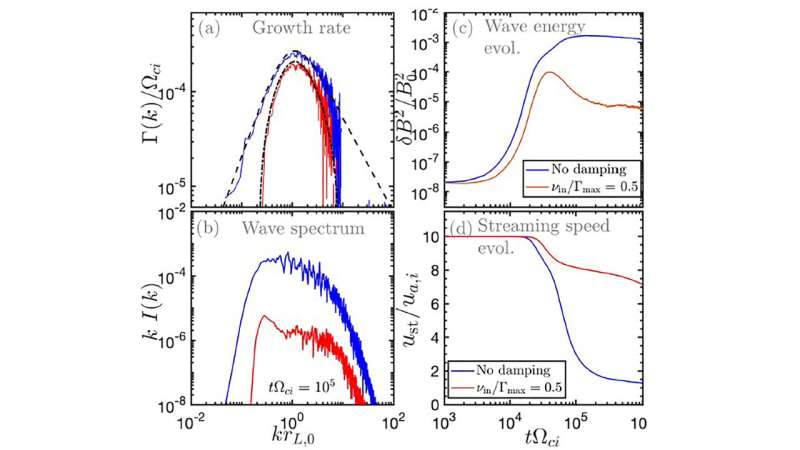Cosmic rays may be key to understanding galactic dynamics

Cosmic rays are charged subnuclear particles that move close to the speed of light, constantly raining down on the Earth. These particles are relativistic, as defined by Albert Einstein's special relativity, and manage to generate a magnetic field that controls the way they move within the galaxy.
Gas within the interstellar medium is composed of atoms, mostly hydrogen and mostly ionized, meaning its protons and electrons are separated. While moving around within this gas, cosmic rays kickstart the background protons, which causes a collective plasma wave movement akin to the ripples on a lake when you toss in a stone.
The big question is how cosmic rays deposit their momentum into the background plasma that composes the interstellar medium. In Physics of Plasmas, plasma astrophysicists in France review recent developments within the field of studying the streaming instability triggered by cosmic rays within astrophysical and space plasma.
"Cosmic rays may help explain aspects of our galaxy from its smallest scales, such as protoplanetary disks and planets, to its largest scales, such as galactic winds," said Alexandre Marcowith, from the University of Montpellier.
Until now, cosmic rays were viewed as being a bit apart within galaxy "ecology." But because instability works well and is stronger than expected around cosmic ray sources, such as supernova remnants and pulsars, these particles likely have far more impacts on galactic dynamics and the star formation cycle than previously known.
"This is not really a surprise, but more of a paradigm shift," Marcowith said. "In science and astrophysics, everything is connected."
Supernova shock waves expanding the interstellar/intergalactic medium "are known to accelerate cosmic rays, and because cosmic rays are streaming away, they may have contributed to generating the magnetic field seeds necessary to explain the actual magnetic field strengths we observe around us," said Marcowith.
After the amplitude of a plasma wave is reduced or damped over time, much like those generated by a stone thrown into a lake, it heats the gas of the plasma. Meanwhile, it helps scatter cosmic rays.
For this to occur, the waves need wavelengths of the same order as the cosmic ray gyro radius. Cosmic rays possess a helical (spiral) motion around the magnetic field, and its radius is called the Larmor radius.
"Say you are driving a car on a winding road. If the wavelength is of the same order as your wheel size, it will be difficult to drive," said Marcowith.
Cosmic rays are strongly scattered by these waves, and the main instability at the origin of these perturbations (waves) is the streaming instability associated with the collective streaming motion of cosmic rays.
"There are several fields of research in astrophysics using similar numerical techniques to investigate the impact of this streaming instability within different astrophysical contexts such as supernova remnants and jets," said Marcowith. "This instability and turbulence it creates may be the source of many astrophysical phenomena, and it shows how cosmic rays play a role in the big circus of our Milky Way."
More information: "The cosmic-ray-driven streaming instability in astrophysical and space plasmas" Physics of Plasmas, aip.scitation.org/doi/full/10.1063/5.0013662
Journal information: Physics of Plasmas
Provided by American Institute of Physics





















